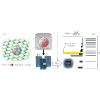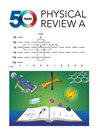Simulating optically active spin defects with a quantum computer
IF 2.9
2区 物理与天体物理
Q2 Physics and Astronomy
引用次数: 0
Abstract
There is a pressing need for more accurate computational simulations of the optoelectronic properties of defects in materials to aid in the development of quantum sensing platforms. In this work, we explore how quantum computers could be effectively utilized for this purpose. Specifically, we develop fault-tolerant quantum algorithms to simulate optically active defect states and their radiative emission rates. We employ quantum defect embedding theory to translate the Hamiltonian of a defect-containing supercell into a smaller, effective Hamiltonian that accounts for dielectric screening effects. Our approach integrates block-encoding of the dipole operator with quantum phase estimation to selectively sample the optically active excited states that exhibit the largest dipole transition amplitudes. We also provide estimates of the quantum resources required to simulate a negatively charged boron vacancy in a hexagonal boron nitride cluster. We conclude by offering a forward-looking perspective on the potential of quantum computers to enhance quantum sensor capabilities and identify specific scenarios where quantum computing can resolve problems traditionally challenging for classical computers.

用量子计算机模拟光学活性自旋缺陷
目前迫切需要对材料中缺陷的光电特性进行更精确的计算模拟,以帮助开发量子传感平台。在这项工作中,我们探讨了如何有效利用量子计算机来实现这一目的。具体来说,我们开发了容错量子算法来模拟光学活性缺陷状态及其辐射发射率。我们采用量子缺陷嵌入理论,将含缺陷超级电池的哈密顿翻译成一个更小的、有效的哈密顿,其中考虑了介电屏蔽效应。我们的方法将偶极算子的分块编码与量子相位估计相结合,选择性地采样表现出最大偶极转换幅度的光学活性激发态。我们还估算了模拟六方氮化硼簇中带负电的硼空位所需的量子资源。最后,我们从前瞻性的角度探讨了量子计算机在增强量子传感器能力方面的潜力,并确定了量子计算可以解决传统上对经典计算机具有挑战性的问题的具体场景。
本文章由计算机程序翻译,如有差异,请以英文原文为准。
求助全文
约1分钟内获得全文
求助全文
来源期刊

Physical Review A
物理-光学
CiteScore
5.40
自引率
24.10%
发文量
0
审稿时长
2.2 months
期刊介绍:
Physical Review A (PRA) publishes important developments in the rapidly evolving areas of atomic, molecular, and optical (AMO) physics, quantum information, and related fundamental concepts.
PRA covers atomic, molecular, and optical physics, foundations of quantum mechanics, and quantum information, including:
-Fundamental concepts
-Quantum information
-Atomic and molecular structure and dynamics; high-precision measurement
-Atomic and molecular collisions and interactions
-Atomic and molecular processes in external fields, including interactions with strong fields and short pulses
-Matter waves and collective properties of cold atoms and molecules
-Quantum optics, physics of lasers, nonlinear optics, and classical optics
 求助内容:
求助内容: 应助结果提醒方式:
应助结果提醒方式:


